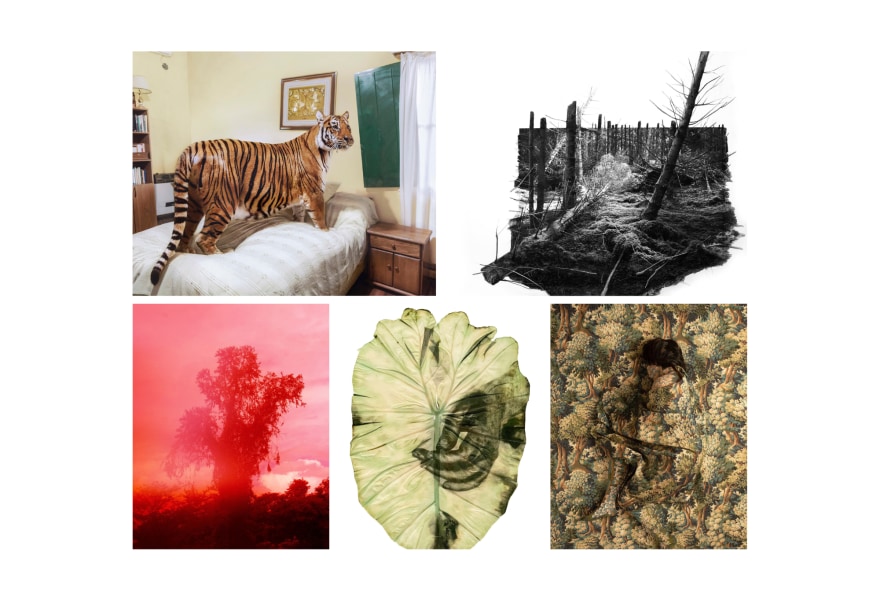19 september 2023, Flor Linckens
Unseen: 5 perspectives on nature
The photography fair Unseen (22-24 September) will take place this week in the iconic Westergas in Amsterdam. 72 galleries from all over the world will present work that conveys the versatility within the medium. You can also visit the Book Market with 65 publishers and of course the exciting UNBOUND section, where artists consider the boundaries of the medium only as a suggestion — resulting in ten fascinating installations. This year's overarching theme, nature, highlights what many artists have been working on recently. The relationship between humans and nature has always had a central role in art history, but in an era of climate change and ecological awareness, this relationship becomes all the more relevant. In this article we highlight five photographers who present work on this subject.
Sofía López Mañán — Carmen Araujo Arte
This Caracas-based gallery from Venezuela shows work by, among others, the Argentinian photographer Sofía López Mañán. For over ten years, she has been focusing on the complicated relationship that humans have with biodiversity. For her practice, the artist regularly collaborates with non-governmental organizations and the Argentinian Ministry of Environmental Affairs. She investigates topics such as biology and nature conservation laws in depth, to gain a deeper understanding of these fields. In her work, she highlights subjects including the illegal trade in wildlife, which effectively illustrates how we as humans view and define nature. Throughout, her work emphasises that nature as we know it today is a cultural construct. Mañán received a National Geographic Emergency Funds for Journalists, for a project that gave her a place on the longlist for World Press Photo.
Almudena Romero — TOBE Gallery
Spanish artist Almudena Romero encourages us to think about our own role in the environmental crisis. Her series "The Pigment Change" was created during her BMW residency. In it, she reflects on creation in a world in which economic production is always central, a world in the midst of an ecological crisis, in which we are inundated with images on a daily basis. Romero asks questions about producing new things in such a world. At the same time, her practice focuses on personal reproduction: her personal choice not to have children due to the climate crisis and the consequences this has in terms of, for instance, her personal legacy. Furthermore, in times when digital photography is ubiquitous, many photographers are interested in the materiality of the photographic process. Romero shares that interest, but also comments on the toxicity of the chemicals that are needed for analog photography. The photographer therefore experiments with other methods, including using natural pigments such as chlorophyll and carotenoids, and with printing on different types of leaves, including wentii or taro leaves, which she coats with bio-resin fossil. An interesting consequence is that this renders her work ephemeral and ultimately impermanent, which only reinforces her questions about production, the commercialisation of photography and her legacy.
Dana Cojbuc — Galerie Écho 119
Other artists seek mystery in nature. The Romanian artist Dana Cojbuc started her series “YGGDRASIL” in 2019 during a residency at the Sunnhordland Museum in Halnsoy, a small Norwegian island. In it, the artist undertakes an immersive journey between photography and drawing in which she let her imagination run free. She redraws the contours of the Norwegian landscape by rearranging the branches and trunks of trees that have been polished by the sea. Using charcoal, she extends her photographic work in order to lead the spectator to imagine new natural panoramas. For the artist, drawing functions as a way of adding mystery, memories and imagination. Cojbuc’s photographic work is fueled by her work in various other artistic disciplines, including video, sculpture and painting. The name of the series refers to the sacred Yggdrasil ‘world-tree’ from Norwegian mythology, a myth in which the world consists of a giant ash tree that extends towards the home of the gods, towards the land of the giants and the underworld.

Elsa Leydier, Untitled #26 from the series LUT-O-A (The Disobediences), 2022, Galerie Caroline O'Breen
Elsa Leydier — Galerie Caroline O'Breen
The practice of French artist Elsa Leydier revolves around the political charge of photography. Her recent series "LUTOA (The Disobediences)" is framed by ecofeminism and concerns the authorised deforestation of the Atlantic Forest in South America. She echoes the recent spread of feminist street collages in Brazil which the word ‘luto’ (‘mourning' in Portuguese) is changed into ‘luta’ (‘fight’) in black paint. Currently, only 8% of the surface which covered Brazil when the Portuguese invaded, remains. The construction of the new industrial port that is currently underway further destroys acres of forest and the seabed. With this project, Leydier speaks of the raise against such injustice and points at the connection of climate change to the economy. In "LUTOA (The Disobediences)", Leydier poses a question: whether the entire system, rather than the individual behaviours, should be destroyed in order to make a change.
Cecilia Paredes — Echo Fine Arts
Other artists are looking for ways to reconnect with nature. The Peruvian multidisciplinary artist and environmental activist Cecilia Paredes is best known for her ‘photo-performances', for which she paints her own body to blend invisibly with the pattern of the background. The patterns in these backgrounds are often borrowed from tapestries or wallpaper and these references to flora and fauna symbolise an ideal world in which humanity is absorbed in the whole without ever wanting to dominate it. In her work — a mix of painting, installation, sculpture and photography — Paredes explores a multitude of themes including exile, integration, connection with nature and biocentrism. Political activism in the 1970s led her to be banned from Peru and she has since lived in several countries, including Mexico and Costa Rica. She currently divides her time between Philadelphia and Lima. In 2005, Paredes represented Costa Rica at the 51st Venice Biennale.




